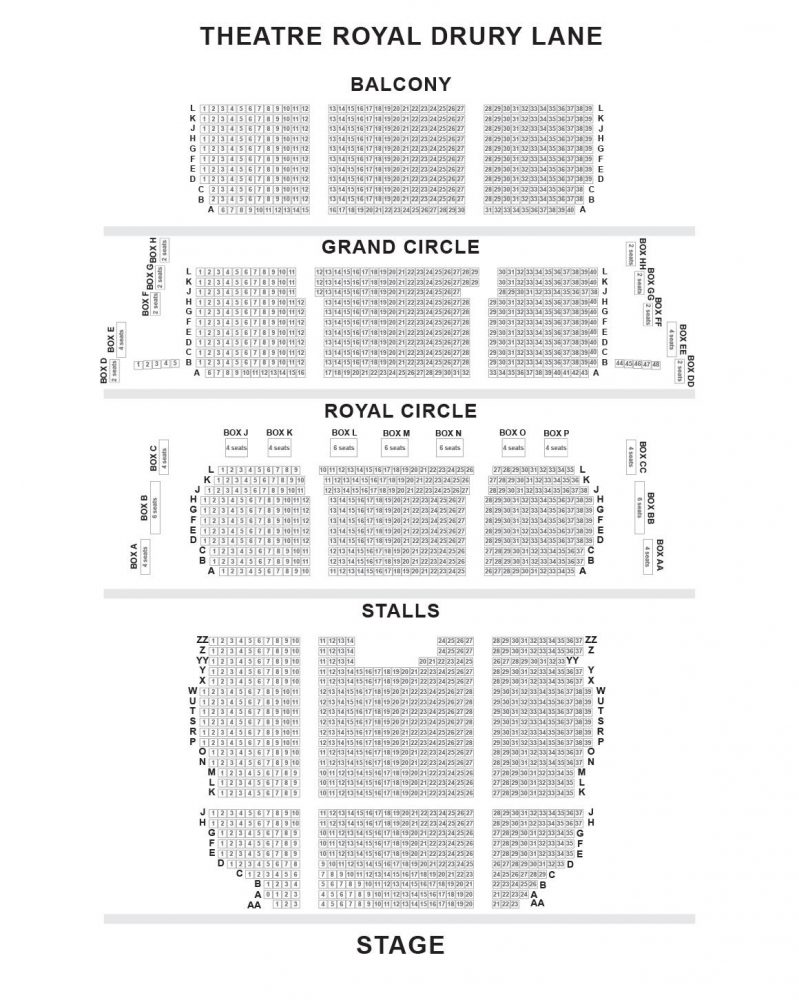
The Theatre Royal Drury Lane is one of London's most spectacular theatres, and has been home to a host of prolific productions. Originally opening in 1663, the venue is one of London's oldest theatres and has been rebuilt and redesigned numerous times. The auditorium is large, and can hold over 2,000 people across four levels, including boxes. The stage is exceptionally large, meaning that views from all levels are good and, whilst it is possible to feel far away from the stage, in many cases a sense of perspective makes for an excellent performance experience.
Stalls
The stalls are the largest seating section in the auditorium and are divided into six blocks of seating, with a front and rear section. The central sections give the best overall views of the stage, and are unobstructed until the rear of the Stalls, where the overhang of the level above becomes visible. Seats towards the end of each row look across the stage rather than directly at it. The back of the Stalls can feel quite far back from the action, with the top of the stage cut off. This means certain parts of the show may be missed.
Royal Circle
The Royal Circle provides excellent views, and feels at level with most of the action on stage. The section is well-raked, meaning views over the heads of the audience in front are not obstructed. The section is free from safety rails, and even seats on the ends of each row have a clear view of the stage. The overhang of the Upper Circle restricts the top of the stage for those on the back rows, but not as significantly as in the Stalls. The section is divided into three blocks of seats, giving excellent accessibility and opportunities for extra legroom.
Grand Circle
The Grand Circle looks down onto the stage at quite a steep angle. The section is quite wide, meaning that some seats towards the ends of the rows can be restricted view. The overhang of the level above begins to come into sight from row E, and the safety rail at the bottom of each aisle can restrict the view of those sitting towards the centre aisles. The section can feel far away from the stage, but it provides panoramic views of the vast stage.
Balcony
The Balcony is the highest level of the auditorium and feels far back from the stage. Because of the height, it may be unsuitable for those who dislike heights or have limited mobility. The section is divided into three blocks of seats, of which the central section has the most unobstructed views. The section is very well raked, giving good views over the heads of the audience in front. Safety bars towards the ends of each row do obstruct the view, although these seats are sold as having a viewing restriction. Patrons may have to lean forward at times depending on where their seats are located.
FAQs
Where are the best seats for children at Theatre Royal Drury Lane?
The best seats for children at the Theatre Royal Drury Lane are in the centre of the Stalls section or the Royal Circle. The Upper Circle and Balcony sections are very far away from the stage, so some children will not be able to see well from these sections. Some children may prefer to sit close to the stage, but older children may enjoy taking in all of the action from the slightly higher Royal Circle. Booster cushions are available for smaller children, and are available by asking an usher inside the venue. Rows A and B of the Balcony are not recommended for children, due to the safety rail in front.
Where are the Restricted View seats?
There are restricted view seats at all levels of the auditorium. These should be clearly marked on your ticket as restricted, and some level of discount applied.
Stalls: The first and final two seats in each row A-J are marked as having a 'side view'. Seats in rows X-ZZ are marked as having the Circle overhang obscuring the view.
Royal Circle: Seats in all boxes are marked as having restricted views.
Grand Circle: Seats towards the central aisles are marked as slightly restricted due to a handrail or pillar being in view. Seats 1-5 and 44-48 have a limited view and you must lean forward to see.
Balcony: Rows A and B are sold as restricted as they have the handrail in view, and you must lean forward to see. Most of the rest of the seats in this level require you to lean forward to some extent to see. These seats are not recommended for children.
What if I am hard of sight or hearing?
The theatre is fitted with an infrared system, with headsets available in the main foyer. An induction loop is available at the Box Office. Seats within the Upper Circle and Balcony have small binoculars available to rent in front of each seat, which should be replaced after use.
How many steps are there in the theatre?
There are 6 steps up to the main foyer and Box Office from street level. The Stalls are accessed by 20 steps down, with a further 17 up, but handrails are available on both sides. There are a further 39 steps up to the Royal Circle, with one handrail, and 61 steps to the Upper Circle. The Balcony can be accessed by a separate entrance, and has 90 steps up to it. For patrons who require step-free access, there is level access to the theatre from the signposted Russell Street door, which has its own doorbell.
Where are the toilets located?
Male and female toilets are located on each level of the auditorium. An adapted toilet is located by the step-free Russell Street entrance to the left of the Stalls.
Where are the bars located?
There is a bar and coffee bar available on the Stalls level and a Grand Saloon bar on the Royal Circle level. The Upper Circle is serviced by one bar, with a further two on the Balcony level. All drinks can be brought to disabled customers in the auditorium on request. Please note the Stalls bar is 17 steps down from the Stalls section.
Are there wheelchair facilities in the theatre?
There are four spaces for wheelchair users in the Stalls section: L1, L35, K1 and K35. Companions are able to sit in the same row. Transfer seating is also available to aisle seats, with space to store wheelchairs and scooters in the Stalls store room. Access dogs are allowed inside the auditorium, and staff can dog-sit for up to four dogs per performance. Row K and C1, C29, D1 and D33 have the most legroom in the Stalls for transfer seating.
 The Theatre Royal Drury Lane is one of London's most spectacular theatres, and has been home to a host of prolific productions. Originally opening in 1663, the venue is one of London's oldest theatres and has been rebuilt and redesigned numerous times. The auditorium is large, and can hold over 2,000 people across four levels, including boxes. The stage is exceptionally large, meaning that views from all levels are good and, whilst it is possible to feel far away from the stage, in many cases a sense of perspective makes for an excellent performance experience.
The Theatre Royal Drury Lane is one of London's most spectacular theatres, and has been home to a host of prolific productions. Originally opening in 1663, the venue is one of London's oldest theatres and has been rebuilt and redesigned numerous times. The auditorium is large, and can hold over 2,000 people across four levels, including boxes. The stage is exceptionally large, meaning that views from all levels are good and, whilst it is possible to feel far away from the stage, in many cases a sense of perspective makes for an excellent performance experience.
 The Theatre Royal Drury Lane is one of London's most spectacular theatres, and has been home to a host of prolific productions. Originally opening in 1663, the venue is one of London's oldest theatres and has been rebuilt and redesigned numerous times. The auditorium is large, and can hold over 2,000 people across four levels, including boxes. The stage is exceptionally large, meaning that views from all levels are good and, whilst it is possible to feel far away from the stage, in many cases a sense of perspective makes for an excellent performance experience.
The Theatre Royal Drury Lane is one of London's most spectacular theatres, and has been home to a host of prolific productions. Originally opening in 1663, the venue is one of London's oldest theatres and has been rebuilt and redesigned numerous times. The auditorium is large, and can hold over 2,000 people across four levels, including boxes. The stage is exceptionally large, meaning that views from all levels are good and, whilst it is possible to feel far away from the stage, in many cases a sense of perspective makes for an excellent performance experience.
